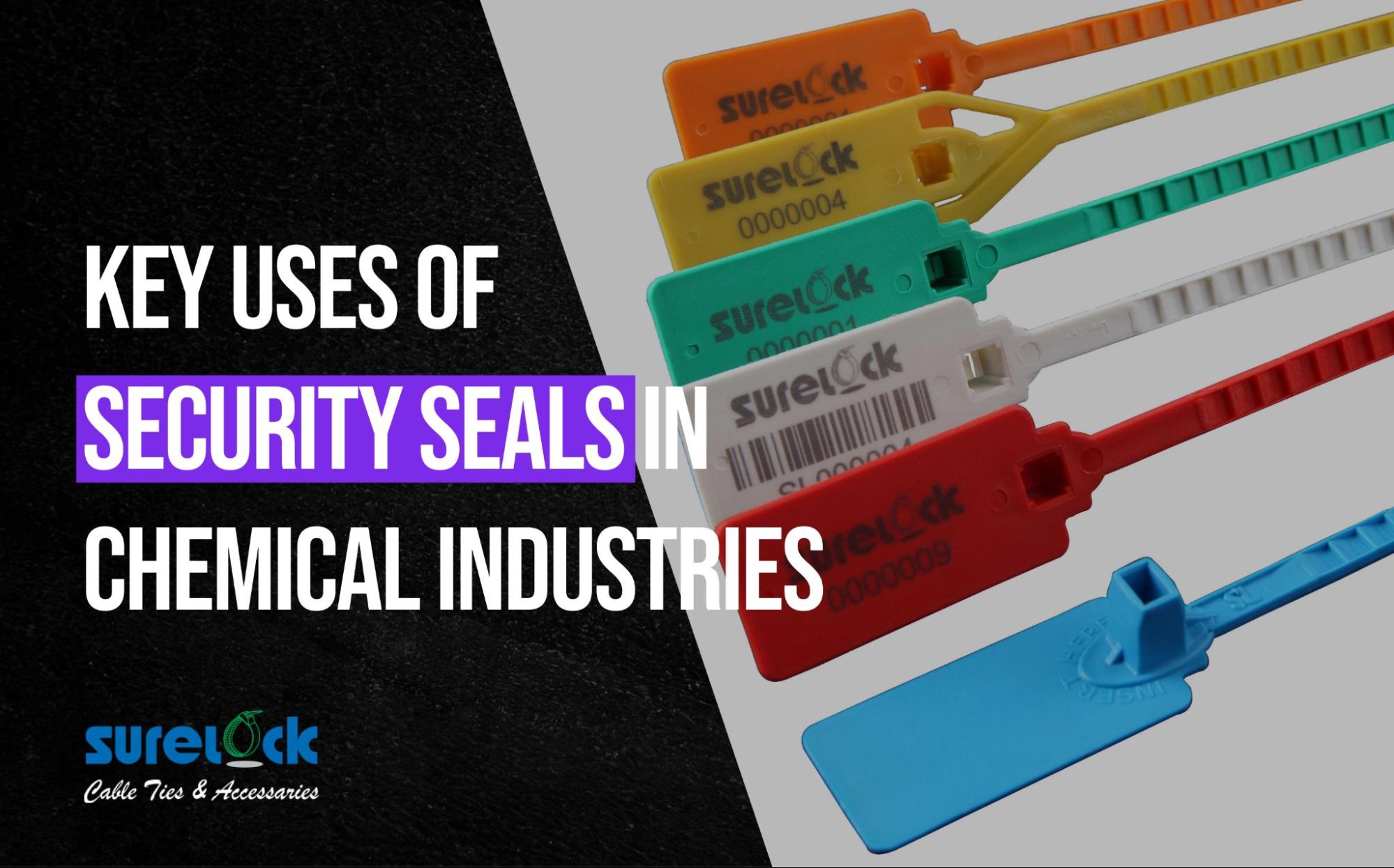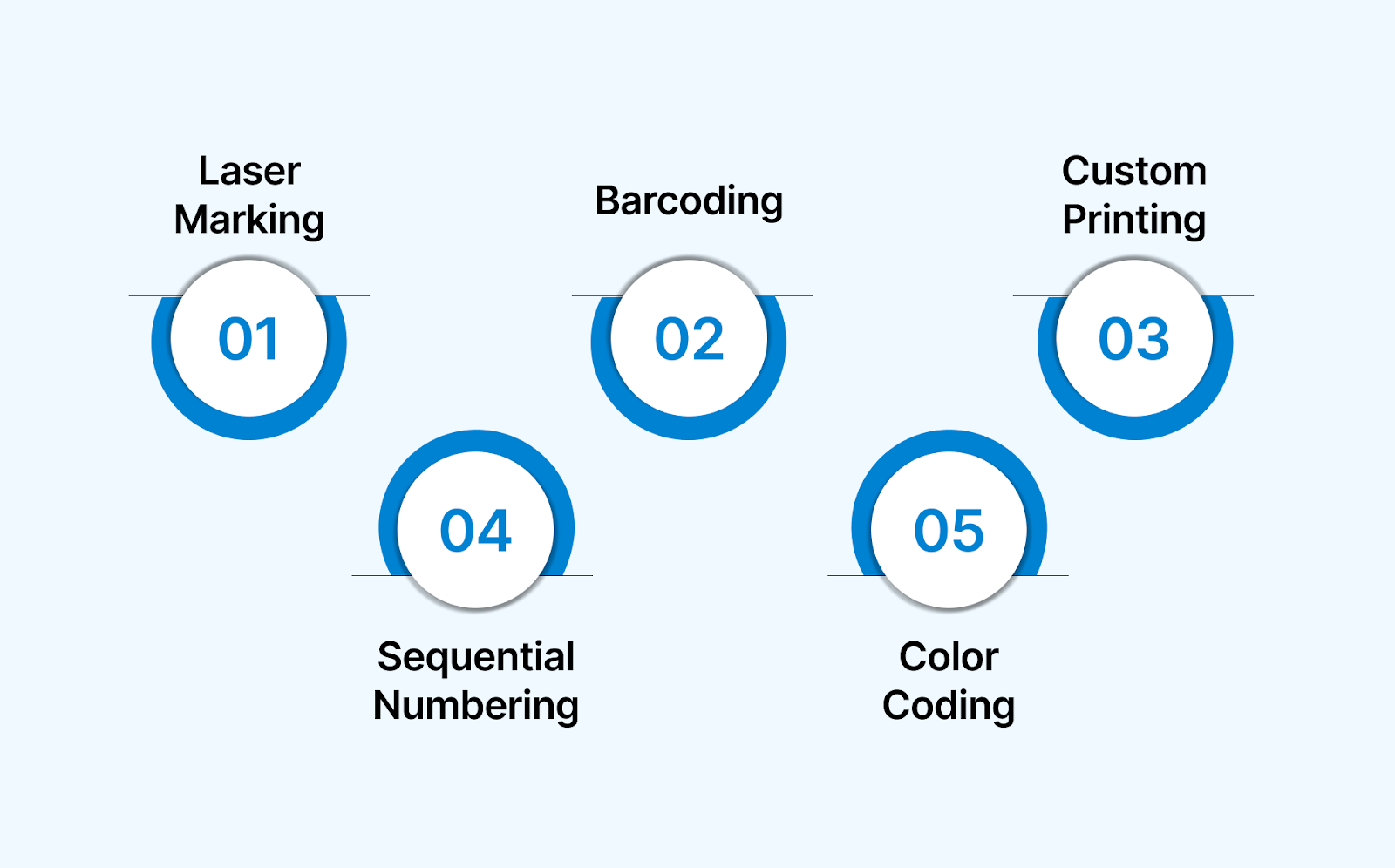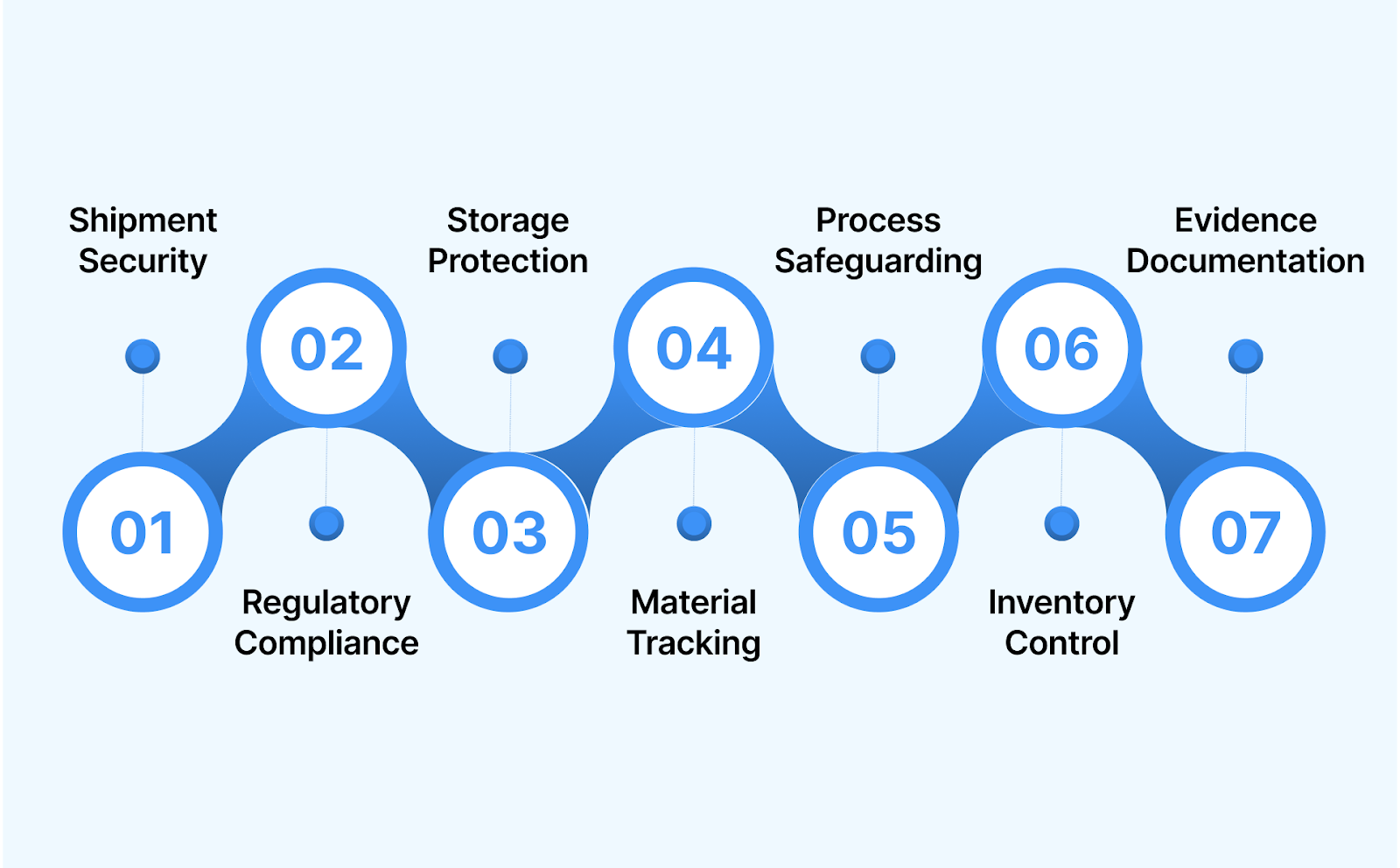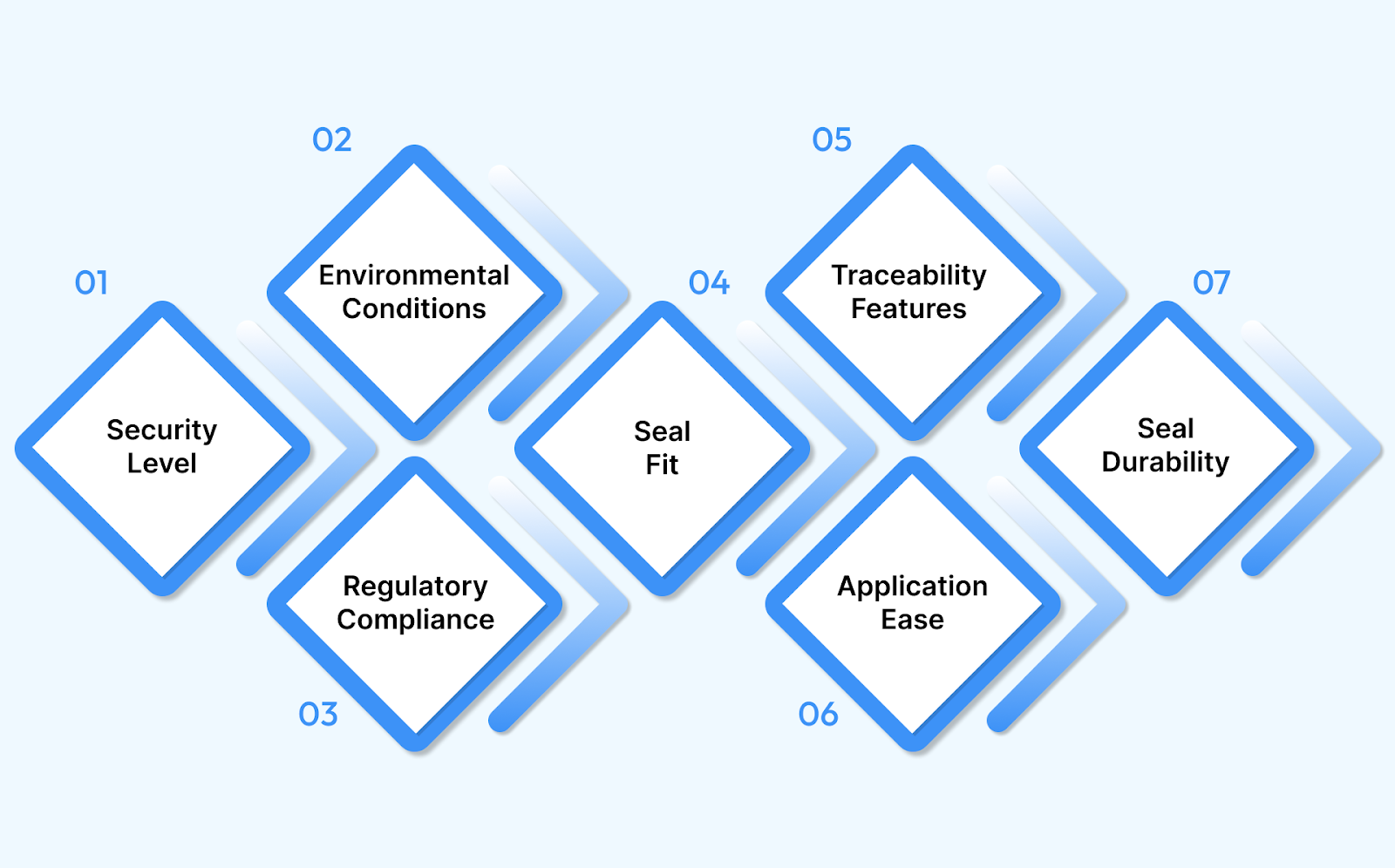Key Uses of Security Seals in Chemical Industries
August 1, 2025

Is your chemical operation truly secure against the threats of tampering and contamination? Ensuring robust security measures is non-negotiable in an industry where safety, compliance, and product integrity are critical.
Security seals provide an essential line of defense, offering a simple yet effective way to prevent tampering, safeguard your products, and maintain regulatory standards.
With rising concerns over theft and contamination, security seals have become indispensable in chemical operations. They offer visible tamper-evidence and peace of mind, knowing your processes are protected from external interference.
In this blog, we’ll dive into the types of security seals used in the chemical industry, their vital roles in protecting shipments and storage, and how to select the right seal for your needs, so that you implement the best practices for securing your operations.
What Are Security Seals?
Security seals are tamper-evident devices designed to provide a visible indication if a container, package, or area has been accessed or compromised. Made from durable materials, these seals are widely used across various industries, including chemical and refinery, to secure goods and ensure compliance with safety regulations.
They act as a safeguard against theft, tampering, or contamination, offering peace of mind that products remain intact and secure throughout storage, transport, and disposal processes.
Now that we understand security seals, let’s explore their key role in safeguarding chemical operations.
Purpose and Advantages of Security Seals in the Chemical and Refining Industry

Security seals serve a crucial purpose in the chemical and refining industries by ensuring that hazardous materials remain intact, secure, and compliant with safety regulations throughout their lifecycle. These seals help minimize risks, protect workers, and safeguard the environment from contamination or unauthorized access. Here’s how they help:
- Tamper Indication: Security seals provide clear visual indicators if a container or drum has been opened or tampered with, ensuring early detection of any unauthorized access.
- Unauthorized Access Prevention: These seals prevent unauthorized personnel from accessing hazardous materials, reducing the risk of theft, misuse, or sabotage.
- Assurance of Integrity: With tamper-evident features, security seals ensure that chemical products remain protected, maintaining their quality and integrity throughout the supply chain.
With the purpose clear, let’s dive into the different types of security seals commonly used in the chemical industry.
Types of Security Seals Used in Chemical Industries
Security seals in the chemical industry come in various designs, each tailored to meet specific needs for tamper-evident protection. Below are the different types of security seals used, explained by their construction and features.
- Security Seal Light Duty: Designed for sealing doors, bags, and drums. Features a self-locking, single-point locking design for tamper-evident security. Length is adjustable, and the identification tag allows for laser marking.
- Security Seal Heavy Duty: It is ideal for sealing doors, bags, and drums. Offers tamper-evident security with a self-locking, single-point locking design. Adjustable length and space for laser marking logos and numbering.
- Double Lock Seal Light Duty: This seal is used for sealing doors, bags, and drums. It features a self-locking, single-point locking design for tamper-evident security. The length is adjustable, and the identification tag supports laser marking.
- Double Lock Seal Heavy Duty: For sealing doors, bags, and drums. Offers tamper-evident security with a self-locking, single-point locking design. Adjustable length and space for laser marking.
- Adjustable Ball Pull-Up Seal: This seal is perfect for sealing door locks, eyelets, drums, and bags. Its ball-shaped adjustable length fits varying diameters, ensuring tamper-proof security. It features an Acetal insert locking mechanism.
- Metal Lock Security Seal Small Tag: This seal is suitable for high-security applications. It features a firm metal insert lock and ultrasonic welding for tamper-proof security. It also includes a gripping spike for use on bags.
- Metal Lock Security Seal Medium Tag: This seal is designed for high-security applications. The metal insert lock and ultrasonic welding ensure tamper-proof security. It also includes a gripping spike for use on bags.
- Round Metal Lock Security Seal: This seal is used for sealing doors, boxes, cabins, or eyelets with a medium breaking force. It features a thin round sealing strap, ultrasonic welding for tamper-proof security, and a gripping spike for bags.
- Bottle Seal: This seal is engineered for high-value cargo security, featuring superior tensile strength for tamper evidence and theft prevention. Its laser-engraved numbering enhances security and prevents component substitution.
- Drum Seal Male/Female: Designed for fiber, HDPE (High-Density Polyethylene drums), and open-mouth drums, this seal fits inside the gap between the metal ring after closure. It is individually numbered and laser-printed for secure and identifiable sealing.
Each type of security seal is specifically designed to meet different security needs in the chemical industry. It ensures that hazardous materials are securely contained, tamper-evident, and easily visible.
Surelock offers a comprehensive range of high-quality security seals, including heavy-duty, double lock, and metal lock seals, designed to provide robust protection for your chemical operations. Explore our diverse seal solutions for every security need.
Now that we’ve covered the types of seals, let’s look at the various marking techniques that enhance their effectiveness.
Security Seal Marking Techniques

Marking security seals is an essential part of ensuring traceability, compliance, and authenticity in chemical industries. These markings provide clear identification and act as tamper-evident indicators, enhancing the security of hazardous materials throughout their lifecycle. Let’s explore top marking techniques:
- Laser Marking: Laser engraving offers permanent, tamper-proof identification on security seals. This high-precision method creates clear, readable marks that can withstand exposure to harsh chemicals and environmental conditions.
- Barcoding: Many security seals are equipped with barcodes, allowing for easy tracking and management of chemical shipments. Barcoded seals improve traceability and provide instant access to important information such as batch numbers and shipment details.
- Custom Printing: Custom printing on seals allows companies to add specific branding, logos, or unique identifiers. This feature helps distinguish seals and increases their effectiveness in tracking and security.
- Sequential Numbering: Security seals often come with sequentially numbered tags, which make it easier to monitor and trace the movement of containers throughout the supply chain. This ensures accountability and reduces the risk of tampering.
- Color Coding: Color-coded seals help differentiate various types of chemical products or specific security levels, making it easier to identify and sort containers quickly during transport and storage.
These marking techniques ensure that security seals in the chemical industry are functional and enhance operational efficiency and compliance with regulatory standards.
Having discussed marking techniques, let's explore the key uses and applications of security seals in the chemical industry.
Key Uses of Security Seals in Chemical Industries

Security seals play a critical role in ensuring safety, compliance, and traceability within the chemical industry. Here are the top uses of security seals in the chemical and refinery industry:
- Securing Chemical Shipments: Security seals prevent theft, pilferage, and contamination during chemical transportation. They offer visible tamper-evidence, ensuring that the chemicals remain sealed and secure until they reach their destination.
- Ensuring Compliance with Regulatory Standards: Security seals help chemical companies meet regulatory requirements such as ISO 17712:2013 (International Organization for Standardization 17712:2013) and EPA (Environmental Protection Agency) guidelines. These seals provide the necessary tamper-evident proof required for hazardous material transportation, ensuring that companies comply with safety standards during transit.
- Protecting Chemical Storage Areas: Security seals are used on storage containers, drums, and warehouses to prevent unauthorized access to hazardous materials. They offer a visible indication of tampering, which is crucial for maintaining safety in chemical storage areas.
- Tracking and Traceability of Hazardous Materials: Security seals, often equipped with unique serial numbers or barcodes, provide accurate tracking of chemicals through the supply chain. This ensures that each batch of chemicals can be traced from storage to shipment and disposal, improving accountability and reducing the risk of misplaced or tampered goods.
- Safeguarding Sensitive Processes: Security seals protect access points in sensitive areas such as chemical mixing stations or hazardous waste disposal sites. These seals ensure that only authorized personnel can access these high-risk zones, reducing the chances of sabotage, accidents, or contamination.
- Enhancing Inventory Control: Security seals on chemical containers and storage units help maintain inventory integrity, prevent unauthorized withdrawals, and ensure that inventory counts are accurate and secure.
- Providing Evidence in Case of Contamination or Accidents: If an incident occurs, such as contamination or a breach in safety protocols, security seals offer important evidence of whether a container has been tampered with. This aids investigations and helps identify points of liability in the supply chain.
At Surelock, our security seals are vital in securing chemical shipments, preventing contamination, and ensuring compliance with industry standards. Trust Surelock to keep your chemical operations safe, secure, and fully compliant.
Considering the uses, let’s focus on selecting the right security seal for your specific chemical application.
Choosing the Right Security Seal for Chemical Applications

Choosing the right security seal is essential to ensuring the safety and compliance of chemical products throughout their lifecycle. Here’s how to select the best security seal for your chemical applications.
- Consider the Level of Security Needed: Identify the risk level associated with the chemical being stored or transported. For high-security requirements, opt for heavy-duty seals that provide extra protection. For lower-risk applications, light-duty seals may suffice.
- Evaluate Environmental Conditions: Consider the chemical environment in which the seal will be used. If exposed to harsh chemicals, extreme temperatures, or outdoor elements, choose seals made from corrosion-resistant materials or weatherproof seals designed to withstand such conditions.
- Check for Regulatory Compliance: Ensure the seal you choose meets the relevant industry standards, such as ISO 17712:2013 or EPA regulations. Tamper-evident seals are required by law for hazardous materials transport, and proper certification ensures compliance.
- Determine Seal Size and Fit: Select seals that are the correct size for your containers. Ensure the seal provides a secure fit, considering the size and type of the container to maintain effective security.
- Look for Traceability Features: Opt for seals that include unique serial numbers, barcodes, or custom labeling for better tracking and traceability. This is especially important for hazardous materials, where full accountability is crucial throughout the supply chain.
- Evaluate Ease of Application and Removal: Select seals that are simple to apply and remove, especially for routine processes. Opt for seals that provide flexibility in handling different container sizes, ensuring ease of use while maintaining strong tamper-evidence.
- Assess Durability and Tamper Resistance: Make sure the seal is durable enough to withstand handling during transport and storage. Look for seals that show clear evidence of tampering, which ensures they can’t be easily bypassed.
Once you know how to choose the right seal, let’s explore best practices for implementing them effectively in chemical operations.
Best Practices for Implementing Security Seals in Chemical Operations

Implementing security seals correctly in chemical operations is crucial for maintaining safety, regulatory compliance, and product integrity. Following the right procedures ensures that your seals perform effectively and protect against tampering and contamination. Here’s what you can do:
- Select the Appropriate Seal: Choose the right type of security seal based on your specific chemical application. For high-security areas, use heavy-duty seals, and for lower-risk situations, opt for light-duty seals.
- Ensure Proper Application: Apply the seal securely to ensure it is tamper-evident. Make sure they are tightly fastened to prevent any movement. Ensure that the seal is fully engaged and cannot be removed without visible evidence of tampering.
- Inspect Seals Regularly: Perform routine inspections to ensure that all security seals are intact and show no signs of tampering. Regular checks should be part of your chemical handling and storage procedures to catch potential issues early.
- Use Seal Tracking Systems: Implement a tracking system for seals that includes unique serial numbers, barcodes, or custom labels. This makes it easy to trace the movement of chemicals throughout the supply chain and helps in audits and inventory management.
- Train Employees on Seal Usage: Proper training is essential for staff to correctly apply, monitor, and inspect security seals. Ensure employees understand the importance of using seals as part of safety protocols, including knowing how to detect tampering.
- Establish Seal Maintenance and Replacement Schedules: Regularly replace seals that are worn, damaged, or expired. Follow a clear maintenance schedule for inspecting and replacing seals to avoid gaps in security or compliance.
- Record Seal Numbers and Details: Keep accurate records of seal numbers, container identifiers, and related shipment or storage information. This ensures accountability and facilitates tracking, helping you stay compliant with industry regulations.
- Incorporate Seals into Emergency Protocols: Include security seals in your emergency response procedures. In case of a breach or contamination, seals should help identify the point of access and ensure that the chemicals remain contained.
By following these best practices, you can ensure the effective use of security seals in chemical operations, safeguarding both products and personnel while maintaining compliance with industry standards.
Conclusion
Security seals are essential for ensuring safety, compliance, and integrity in chemical industries. From preventing unauthorized access to maintaining regulatory standards, these seals play a critical role in protecting hazardous materials throughout their lifecycle. By choosing the right seal, you safeguard not only your products but also your reputation.
At Surelock, we provide a comprehensive range of durable, tamper-evident security seals, including metal lock seals, double lock seals, and cable seals, all designed to meet the unique demands of the chemical industry. Trust Surelock for the highest level of security and compliance in your operations.



